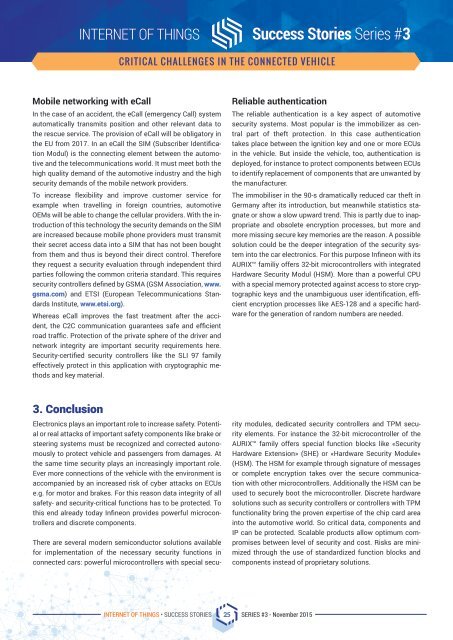Success Stories
VEZSJ
VEZSJ
Create successful ePaper yourself
Turn your PDF publications into a flip-book with our unique Google optimized e-Paper software.
Internet of Things <strong>Success</strong> <strong>Stories</strong> Series #3<br />
Critical Challenges in the Connected Vehicle<br />
Mobile networking with eCall<br />
In the case of an accident, the eCall (emergency Call) system<br />
automatically transmits position and other relevant data to<br />
the rescue service. The provision of eCall will be obligatory in<br />
the EU from 2017. In an eCall the SIM (Subscriber Identification<br />
Modul) is the connecting element between the automotive<br />
and the telecommunications world. It must meet both the<br />
high quality demand of the automotive industry and the high<br />
security demands of the mobile network providers.<br />
To increase flexibility and improve customer service for<br />
example when travelling in foreign countries, automotive<br />
OEMs will be able to change the cellular providers. With the introduction<br />
of this technology the security demands on the SIM<br />
are increased because mobile phone providers must transmit<br />
their secret access data into a SIM that has not been bought<br />
from them and thus is beyond their direct control. Therefore<br />
they request a security evaluation through independent third<br />
parties following the common criteria standard. This requires<br />
security controllers defined by GSMA (GSM Association, www.<br />
gsma.com) and ETSI (European Telecommunications Standards<br />
Institute, www.etsi.org).<br />
Whereas eCall improves the fast treatment after the accident,<br />
the C2C communication guarantees safe and efficient<br />
road traffic. Protection of the private sphere of the driver and<br />
network integrity are important security requirements here.<br />
Security-certified security controllers like the SLI 97 family<br />
effectively protect in this application with cryptographic methods<br />
and key material.<br />
Reliable authentication<br />
The reliable authentication is a key aspect of automotive<br />
security systems. Most popular is the immobilizer as central<br />
part of theft protection. In this case authentication<br />
takes place between the ignition key and one or more ECUs<br />
in the vehicle. But inside the vehicle, too, authentication is<br />
deployed, for instance to protect components between ECUs<br />
to identify replacement of components that are unwanted by<br />
the manufacturer.<br />
The immobiliser in the 90-s dramatically reduced car theft in<br />
Germany after its introduction, but meanwhile statistics stagnate<br />
or show a slow upward trend. This is partly due to inappropriate<br />
and obsolete encryption processes, but more and<br />
more missing secure key memories are the reason. A possible<br />
solution could be the deeper integration of the security system<br />
into the car electronics. For this purpose Infineon with its<br />
AURIX familiy offers 32-bit microcontrollers with integrated<br />
Hardware Security Modul (HSM). More than a powerful CPU<br />
with a special memory protected against access to store cryptographic<br />
keys and the unambiguous user identification, efficient<br />
encryption processes like AES-128 and a specific hardware<br />
for the generation of random numbers are needed.<br />
3. Conclusion<br />
Electronics plays an important role to increase safety. Potential<br />
or real attacks of important safety components like brake or<br />
steering systems must be recognized and corrected autonomously<br />
to protect vehicle and passengers from damages. At<br />
the same time security plays an increasingly important role.<br />
Ever more connections of the vehicle with the environment is<br />
accompanied by an increased risk of cyber attacks on ECUs<br />
e.g. for motor and brakes. For this reason data integrity of all<br />
safety- and security-critical functions has to be protected. To<br />
this end already today Infineon provides powerful microcontrollers<br />
and discrete components.<br />
There are several modern semiconductor solutions available<br />
for implementation of the necessary security functions in<br />
connected cars: powerful microcontrollers with special security<br />
modules, dedicated security controllers and TPM security<br />
elements. For instance the 32-bit microcontroller of the<br />
AURIX family offers special function blocks like «Security<br />
Hardware Extension» (SHE) or «Hardware Security Module»<br />
(HSM). The HSM for example through signature of messages<br />
or complete encryption takes over the secure communication<br />
with other microcontrollers. Additionally the HSM can be<br />
used to securely boot the microcontroller. Discrete hardware<br />
solutions such as security controllers or controllers with TPM<br />
functionality bring the proven expertise of the chip card area<br />
into the automotive world. So critical data, components and<br />
IP can be protected. Scalable products allow optimum compromises<br />
between level of security and cost. Risks are minimized<br />
through the use of standardized function blocks and<br />
components instead of proprietary solutions.<br />
Internet of Things • <strong>Success</strong> <strong>Stories</strong> 25 SERIES #3 - November 2015









